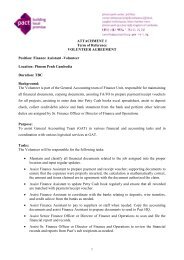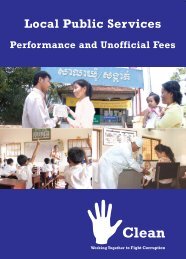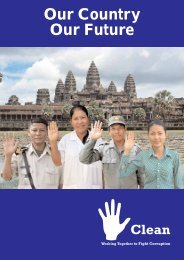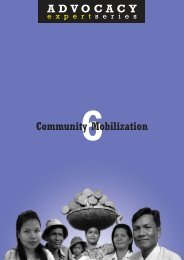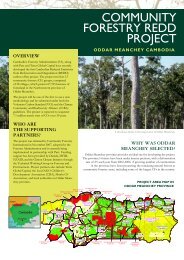Advocacy in Cambodia: Increasing Democratic ... - Pact Cambodia
Advocacy in Cambodia: Increasing Democratic ... - Pact Cambodia
Advocacy in Cambodia: Increasing Democratic ... - Pact Cambodia
Create successful ePaper yourself
Turn your PDF publications into a flip-book with our unique Google optimized e-Paper software.
Increas<strong>in</strong>g <strong>Democratic</strong> Space<br />
Labor Code, an exposure trip to other countries<br />
with Labor Codes based on <strong>in</strong>ternational best<br />
practices helped to improve relations. Advocates<br />
for the Commune Council Election Law suggest<br />
that exposure trips helped make NEC<br />
representatives more open-m<strong>in</strong>ded when they<br />
received requests from the EMOs.<br />
Includ<strong>in</strong>g Authorities from the Start<br />
Another strategy to raise concern among<br />
communities and local authorities is to make<br />
awareness rais<strong>in</strong>g activities part of a series of<br />
activities. LICADHO’s Child Labor program <strong>in</strong><br />
Siem Reap starts with workshops at various levels<br />
(prov<strong>in</strong>cial and district authorities, departments,<br />
parents, and children). Participants were <strong>in</strong>vited<br />
to attend a series of three or four workshops, and<br />
then asked to send two representatives from the<br />
workshops to attend a monthly meet<strong>in</strong>g.<br />
LICADHO’s strategy to generate concern about a<br />
situation has succeeded and participants <strong>in</strong> the<br />
monthly meet<strong>in</strong>gs (<strong>in</strong>clud<strong>in</strong>g department officials)<br />
have <strong>in</strong>itiated action when cases of child labor<br />
abuse have been brought to their attention. Part<br />
of the success of the program is attributed to the<br />
identification of community members who<br />
demonstrated concern about child labor and took<br />
action on their own <strong>in</strong>itiative prior to the<br />
LICADHO workshops.<br />
Lobby<strong>in</strong>g<br />
Lobby<strong>in</strong>g is the act of hav<strong>in</strong>g direct contact<br />
with government officials to conv<strong>in</strong>ce them to<br />
represent advocacy campaign concerns with<strong>in</strong><br />
government. To accomplish this, <strong>in</strong> addition to<br />
workshops and conferences, advocates meet<br />
directly with lawmakers and other government<br />
officials. Meet<strong>in</strong>gs can be set up formally through<br />
their offices but most often they are done<br />
<strong>in</strong>formally through personal diplomacy. As this<br />
type of activity is fairly high level, lobbyists must<br />
have a certa<strong>in</strong> amount of status or legitimacy <strong>in</strong><br />
order to be able to access lawmakers. They must<br />
also have strong network<strong>in</strong>g capacity and many<br />
contacts. One of the challenges experienced by<br />
young <strong>Cambodia</strong>n professionals is difficulty <strong>in</strong><br />
break<strong>in</strong>g <strong>in</strong>to high circles for lobby<strong>in</strong>g purposes.<br />
Advocates have found that while government<br />
officials are privately will<strong>in</strong>g to express their views<br />
and even support arguments presented by<br />
advocates, this does not usually translate <strong>in</strong>to<br />
support for a cause when they are <strong>in</strong> public. Such<br />
was the case dur<strong>in</strong>g the Commune Council<br />
Election Law campaign. Lobbyists have to<br />
recognize that most mid-level lawmakers are<br />
hesitant to advocate for certa<strong>in</strong> issues due to fear<br />
of more powerful counterparts <strong>in</strong> the government.<br />
Even when government officials <strong>in</strong>dicate that they<br />
are will<strong>in</strong>g to hear recommendations, advocates<br />
<strong>in</strong> <strong>Cambodia</strong> are careful to avoid submitt<strong>in</strong>g these<br />
too openly, lest the officials feel they lose face.<br />
As lobby<strong>in</strong>g <strong>Cambodia</strong>n government officials<br />
has had a limited effect <strong>in</strong> the past, NGO leaders<br />
tend to focus lobby<strong>in</strong>g efforts on foreign embassies<br />
and bilateral agencies, both <strong>in</strong> the country and<br />
abroad. Their purpose is to appeal to these<br />
agencies to act as <strong>in</strong>termediaries for them, and the<br />
reality is that at present that this type of lobby<strong>in</strong>g<br />
tends to yield better results. Critics of the use of<br />
lobby<strong>in</strong>g as a means to <strong>in</strong>fluence policy believe that<br />
this is not a long-term solution. In their view<br />
advocates may be rely<strong>in</strong>g too heavily on this type<br />
of lobby<strong>in</strong>g. In contrast, others suggest that<br />
lobby<strong>in</strong>g that conv<strong>in</strong>ces some donors to<br />
<strong>in</strong>corporate fund conditionality opens the door for<br />
local activists to engage with policy makers and<br />
provides a protective environment for advocacy<br />
to grow.<br />
Network<strong>in</strong>g<br />
Work<strong>in</strong>g with<strong>in</strong> a network of organizations<br />
<strong>in</strong>terested <strong>in</strong> the same advocacy issue presents<br />
another important strategy that can create broadbased<br />
support for an issue and legitimize an<br />
advocacy campaign. By work<strong>in</strong>g together through<br />
networks, NGOs ga<strong>in</strong> greater legitimacy with their<br />
advocacy audience. This strategy is well known to<br />
<strong>in</strong>ternational organizations that formed networks<br />
early on when they began to work <strong>in</strong> <strong>Cambodia</strong> –<br />
thus was created the CCC, MEDICAM, and the<br />
NGO Forum on <strong>Cambodia</strong>. These membership<br />
associations facilitate communication and the flow<br />
of <strong>in</strong>formation between government and NGOs.<br />
S<strong>in</strong>ce the mid-1990s, the proportion of local NGOs<br />
represented <strong>in</strong> these membership organizations<br />
has been steadily <strong>in</strong>creas<strong>in</strong>g.<br />
The existence and coord<strong>in</strong>ation of networks<br />
with<strong>in</strong> a sector is a good <strong>in</strong>dication of the strength<br />
of that sector. Most sectors have at least one<br />
network and some of the broader sectors have<br />
more than one. While some sectors have strong<br />
coord<strong>in</strong>ation, such as the fisheries sector, others<br />
are more loosely organized, such as the women’s<br />
sector. Networks at the prov<strong>in</strong>cial levels tend to<br />
be better organized and coord<strong>in</strong>ated. Prov<strong>in</strong>cial<br />
NGOs rely on these networks for <strong>in</strong>formation and<br />
protection ga<strong>in</strong>ed from be<strong>in</strong>g part of a larger<br />
organized campaign. The four advocacy networks<br />
organized by Star Kampuchea provide a venue for<br />
NGOs from various sectors to come together to<br />
address advocacy issues. As networks represent<br />
an important aspect of advocacy capacity, they are<br />
discussed <strong>in</strong> greater detail <strong>in</strong> the section on impact.<br />
28






